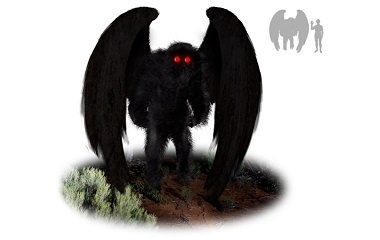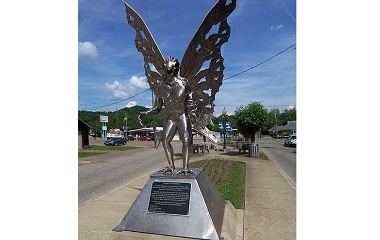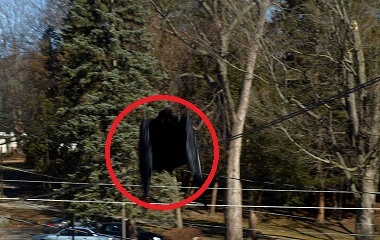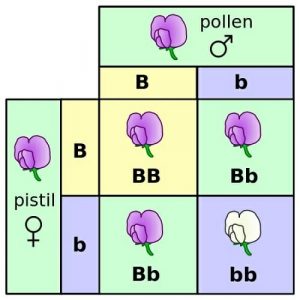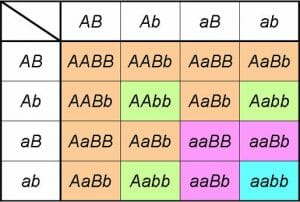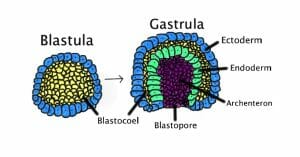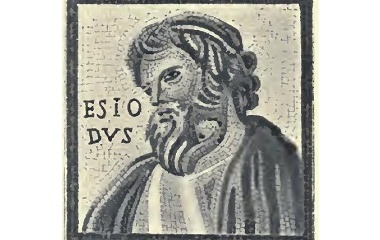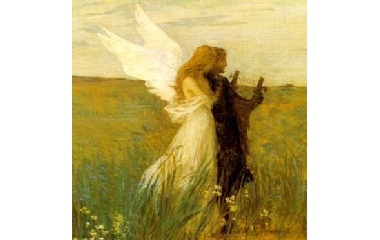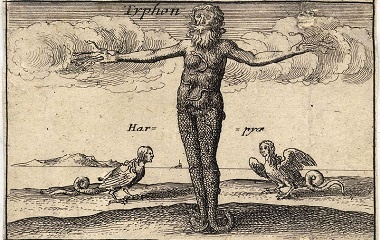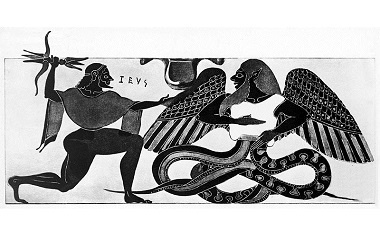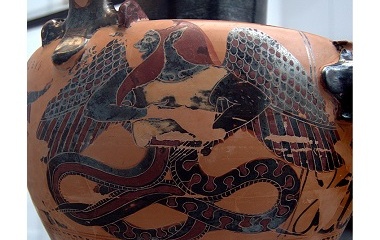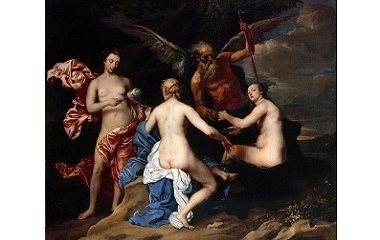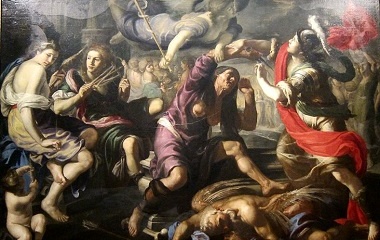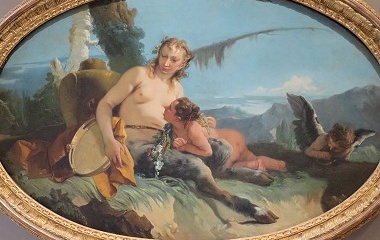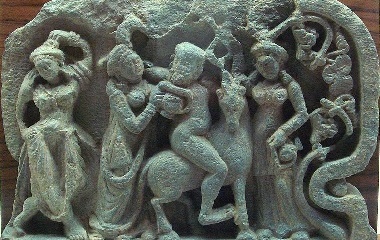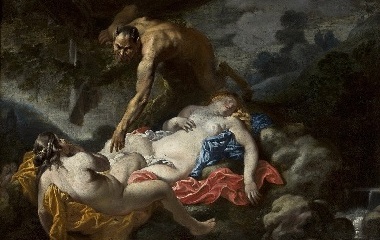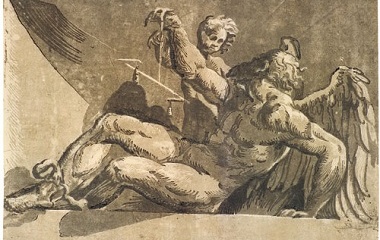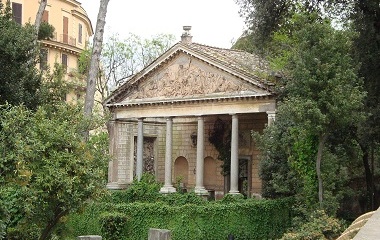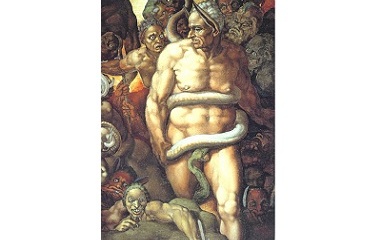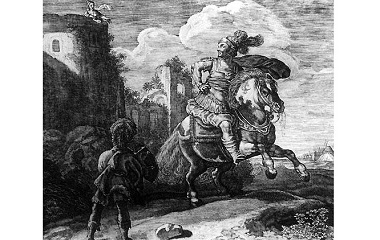It was the year 1966 when a strange creature surfaced in the small town of Point Pleasant, West Virginia. This creature was described as being at least 7 feet tall, with a humanoid body and a wingspan at least 10 feet in length. Its distinguishing feature? Two red glowing eyes that terrified anyone who saw them. For the next year, this strange moth-like creature continued to terrorize the residents of Point Pleasant. Thus, the legend of the Mothman was born.
Who is Mothman?
Mothman is a large creature thought to inhabit the TNT area located just outside of Point Pleasant, West Virginia. This winged creature first appeared on November 12, 1966 in front of five men who were digging a grave in Clendenin, West Virginia (approximately 1 hour and 20 minutes away from Point Pleasant).
Just three days later, on November 15, two couples going for a night-time drive through the TNT area spotted the creature again. Terrified, they sped off at over 100 miles per hour, but the strange being had no trouble keeping up with them. The couples were chased back into town, where they reported their sighting to Deputy Sheriff Millard Halstead.
The next day, Deputy Halstead and the couples held a press conference at the city courthouse to share the story. It was then that the creature was named ‘Mothman’ because of its strange appearance. Later that night, another famous sighting occurred when Marcella Bennett drove to a friend’s house, which happened to be located inside the TNT area. When she got out of the car with her baby, she was startled as a large creature started to come out of the shadows near her car. Her fright caused her to drop her young child, though she quickly recovered from her shock. She picked up the baby, ran inside, and quickly locked the doors. Mothman climbed onto the porch and peered through the windows at the family, but disappeared before the police arrived.
Over the next few months, Mothman terrorized the town. Nearly 100 people came forward with eyewitness reports between November 1966 and December 1967. During this time, the town of Point Pleasant also experienced paranormal and possibly extraterrestrial activity that was thought to be somehow linked to Mothman.
Characteristics
Physical Description
Those who saw Mothman claim that he was a large, grey, humanoid type creature with massive wings. He is thought to stand between 5 and 7 feet tall with a 10-foot wing span. Mothman’s head is described as being oddly shaped, and sitting close to the creature’s body. Some people even describe him as being headless, with only two eyes protruding above his torso. Additionally, his bright-red glowing eyes are said to be extremely large.
Mothman is also capable of incredible flying capabilities. The couple who saw him the night of November 15, 1966 outside of the TNT area said he was able to keep up with their car at 100 miles per hour without flapping his wings. He is also capable of weaving quickly in between dense forest areas and rising straight into the sky like a helicopter. These flight patterns are beyond our current capabilities with solo-flight devices like jetpacks, causing many people to disregard the possibility of a prank.
Personality
Though many people are divided on the nature of the Mothman, it has been noted that the creature has never harmed a human being during its encounters. This has caused many believers to think that the Mothman means no harm, but instead tries to warn people of impending danger with its presence. This was later evidenced further with the collapse of the Silver Bridge, as many witnesses claimed to see the Mothman on the bridge just before it fell.
Others make arguments for the creature’s evil nature, and cite the disappearance of Newell Partridge’s dog and the ancient legend of Chief Cornstalk as evidence. It is their belief that the Mothman is a creature of danger and chaos who seeks to put humans in dangerous situations.
Origin Theories
Alien Creature
Many people claim to have witnessed UFO sightings and paranormal experiences during Mothman’s time in Point Pleasant, leading many to believe that Mothman could be an extraterrestrial creature. The arrival of the mysterious Indrid Cold (also known as ‘The Grinning Man’) seems to give this theory foundation.
On November 2, 1966 (10 days before the first Mothman sighting), Woodrow Derenberger was driving back to his home in Mineral Wells, West Virginia when he was cut off by what he thought was a car. The vehicle forced him to slow down and then pull over on the side of the road. When he got closer, he realized that the contraption was not a car, but a strange craft that resembled a ‘kerosene lamp chimney.’
A figure then exited the craft and walked to his car. The figure looked very human in appearance and was wearing a coat that was a metallic blue color. He spoke to Woodrow and told him that he meant him no harm. Strangely, the man did not move his lips and his mouth remained fixed in its smile—which later led people to call him ‘The Grinning Man.’ Woodrow realized that the man was speaking to him telepathically.
The man introduced himself as Indrid Cold and told Woodrow that he was from a different galaxy. They conversed for nearly 10 minutes before the strange man returned to his craft. Before he left, he told Woodrow to report his experience to the authorities. Woodrow’s story was published and corroborated by several witnesses who saw him pulled over on the road and talk to a strange man. Several of the witnesses were even able to describe the odd craft.
Others who saw the Mothman were questioned by strange ‘Men in Black’ with pale, translucent skin. They were asked if they had witnessed the Mothman and (if so) what they had specifically seen. Many people reported that they talked in a strange, almost robotic tone that made them nervous. Anyone who was questioned and who had, in fact, seen something related to the Mothman was told to remain quiet on the subject. Several of the witnesses received anonymous threatening phone calls that warned them not to speak about the Mothman. Extraterrestrial enthusiasts claim that the descriptions of these strange men match those of an alien species.
The sightings of these strange men combined with the Mothman leads many to believe that the Mothman may be an extraterrestrial creature that somehow found its way to Earth.
Mutated Monster
Others who believe in the Mothman prefer a more scientific approach. Their theories about the Mothman’s origins are largely influenced by the home of the creature: the TNT area.
The TNT area was constructed during World War II. It was situated near a large wildlife preservation area, ensuring that the area was remote and rarely frequented. The TNT area is comprised of many miles of igloo-type concrete domes. The military used these spaces to create and store weapons of mass destruction. After the war, the site was abandoned. Many toxic substances from the weapons that were stored leaked out into the surrounding forest area.
There are some that believe that the Mothman was affected by these chemicals. They believe that somehow a creature’s DNA was fused with toxic chemicals and somehow mutated into a strange, humanoid creature. Those who believe this think Mothman is our own doing and believe we should deal with the consequences accordingly.
Vengeful Curse
Still others believe Mothman is the embodiment of a 200-year-old curse. This curse can be traced back to the death of Chief Cornstalk and several of his tribesman. Chief Keigh-tugh-gua (which is translated to cornstalk) wanted peace with the American colonists who were trying to occupy the land of seven different Native American nations. Unfortunately, there were many on both sides who opposed this idea.
On November 7, 1777, Chief Cornstalk traveled to a fort in an area called Point Pleasant and tried to engage in peace talks with the colonists to prevent fighting. He insisted that peace was necessary because the British were trying to convince the other nations to join with them to oppose the colonists and that only he and his tribe stood in their way. However, he feared he could not hold them back much longer. Fearful, the colonists took him and his companions prisoner and detained them inside their fort. Chief Cornstalk was considered to be a skilled fighter and military genius and was greatly respected by both sides. By detaining him, the colonists hoped that they could prevent the Native Americans from attacking. Two days later (November 9, 1777) Chief Cornstalk’s son, Ellinipisco, visited the fort to see his father and was also detained.
On November 10, 1777, gunfire was heard near the Kanawha River. When soldiers from the fort went to investigate, they found that two men who had left to hunt for deer had been ambushed by Native Americans. One was dead. Enraged, the soldiers burst into the quarters of Chief Cornstalk and his companions and brutally murdered them as revenge.
As he laid dying on the ground, Chief Cornstalk is said to have uttered a curse on the land in which he died. He spoke the following words:
Strange events occurred later in history, such as a lightning bolt that twice destroyed a monument erected in honor of the colonists who fought for the Ohio River Valley. When the Mothman appeared in Point Pleasant, West Virginia, many people were convinced that he was yet another punishment set upon the land from the angered spirit of Chief Cornstalk.
Sightings
The Collapse of the Xiaon Te Dam
Surprisingly, the first sighting of the Mothman may be traced back 40 years before he appeared in Point Pleasant. The beginning of January 1926 opened with the appearance of a strange creature in Southeastern China. The locals described this creature as a ‘man dragon’ that could frequently be seen hovering over the Xiaon Te Dam.
On January 19, 1926, the Xiaon Te Dam collapsed, releasing nearly 40 billion gallons of water into the surrounding farms in the valley. The death toll is estimated to be well over 15,000, though many of records of this disaster have since been destroyed.
November 12 to November 16, 1966
On November 12, 1966, the Mothman was first sighted flying over a cemetery by five men who were digging a grave late at night. They described the creature they saw as man-like figure who could fly.
Three days later, on the night of November 15, 1966, Newell Partridge’s dog started growling at a creature outside. Partridge heard an odd noise and went outside to investigate with a flashlight. He was startled to discover the Mothman. Partridge quickly tried to call his dog back into the house, but the dog (who was a trained hunting dog) darted off into the night. Partridge ran into the house to grab his rifle and go after his dog, but was too scared to go back outside. He never saw the dog again.
The same night, two married couples were taking a late-night drive out of Point Pleasant to the TNT area. They saw a large dog carcass on the side of the road on their way out. Upon reaching the TNT area, they saw a large, winged humanoid with glowing red eyes. The creature chased them back into town and managed to keep up with them even though they were speeding at 100 miles per hour. As they drove back into town, they noticed that the dog’s carcass was gone. They went back to look for it later but it was never found. Many believe the dog’s carcass was Newell Partridge’s hunting dog.
On the night of the 16th, Marcella Bennett was driving to a friend’s house at night. She got out of the car with her baby and was startled as she saw the Mothman rise up next to her car. She was so startled that she dropped her baby. She quickly recovered however, and rushed inside with her child and locked the doors. The Mothman reportedly walked up the steps of the porch and peered into the house with its glowing red eyes. By the time the police arrived to investigate, it had disappeared.
Hundreds of other sightings would be reported during this time, though these are the most notable.
The Collapse of the Silver Bridge
On December 15, 1967 the Silver Bridge collapsed during rush hour traffic. In the hours before the collapse (and even during the event) many witnesses claimed to have seen the Mothman atop the bridge. The collapse was devastating, and 46 people lost their lives as their cars were plunged into the river below. The Mothman was never seen in Point Pleasant again.
The Collapse of the Freiburg Mine
On the morning of September 10, 1978, a group of miners was heading to work in Freiburg, Germany, when they were confronted by a strange man in a trench coat. When they got closer, they realized it wasn’t a man, but a strange creature with huge wings. It appeared to have no head, but had large glowing red eyes on what seemed to be its chest. They stood in the entrance of the mine staring at the creature until it let out a terrifying scream that made them turn and run away from the mine. An hour later, the mine collapsed.
Chernobyl
Throughout the year of 1985, many scientists, workers, and citizens who lived near the power plant in Chernobyl, Ukraine, saw a large bird-like creature with the body of a man flying around the nuclear plant. They claimed this terrifying creature had glowing red eyes.
On April 26, 1986, the creature was spotted before a huge explosion that became one of the most famous nuclear accidents in history. Witnesses also saw the creature flying through the smoke and wreckage after the horrifying event.
9/11 and the Twin Towers
Several days before the terrible attack on September 11, 2001, several people saw a strange flying creature near the Twin Towers. Those who saw the attack report that the same creature was flying parallel to the second plane as it hit the tower.
The Collapse of the I-35 Bridge
At the end of June in 2007, reports of Mothman began surfacing in Minnesota. The reports were concentrated in Minneapolis, the surrounding areas, and the I-35 Bridge itself. After a month of sightings, the bridge collapsed on August 1, 2007. The collapse was devastating, killing 13 people and injuring 145 others.
The Swine Flu Outbreak
Residents in La Junta, Mexico began seeing a large, black, red-eyed creature in 2009. The creature reportedly stalked the town just before the swine flu outbreak that devastated the area. Several witnesses report being terrified by its screaming, and one was even chased by the creature. Local authorities searched for evidence of the creature, but it was never found.
Fukushima
Two witnesses were out near Japan’s Fukushima power plant in March 2011 when they heard a loud screech. They turned back to see a creature sitting on top of the Fukushima plant. It suddenly unfurled its wings and began to fly towards them. They were horrified by a pair of glowing red eyes that were looking right at them, but the creature disappeared soon after.
Shortly after the creature appeared to them, Fukushima was devastated by an earthquake and the nuclear power plant the witnesses walked by exploded.
Related Characters
In ancient lore and mythology, there are many mentions of doom prophets and winged creatures that match the description of Mothman.
Assyrian mythology speaks of a demon named Pazuzu. He was the king of the demons of the wind and represented the southwest wind. He is often described as having a combination of human and animal parts, as well as having massive wings. However, despite being evil in nature, Pazuzu protects humans from plagues and misfortune.
Greek mythology also gives us Thanatos. Thanatos is a large winged god that personifies death. He appeared to humans when the time they had been given by the Fates had run out, and carried them to the Underworld.
Explanation of the Myth
As sightings of this cryptid continue into present day, many people wonder if the Mothman is more than a myth that haunts the town of Point Pleasant. There seems to be no consensus on whether the creature means harm towards human, though it can be agreed that sightings of the Mothman seem to precede tragedies and loss of life.
Mothman
